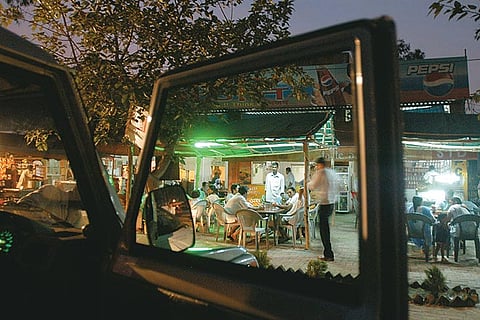

I was sitting on a charpoy at Tyagiji&rsquos dhaba at Gajraula. This was the place Antara Mali deserted to have a shot at Bollywood in Main Madhuri Dixit Banna Chahti Hoon. I could see why. Sarabjeet Singh lathered his big brawny body with a conspicuous bar of red Lifebuoy at a tank near the dhaba. His khalassi had just finished with his bath but there was little he could do about his dirty mouth, &ldquoMain kya b*******, zara dal lagana.&rdquo The proprietor Choudhary Chetram or Tau sat on a charpoy in all his shirtless glory with a hookah. What woman could stand so much testosterone But where Gajraula lost out on its woman count, it made up in terms of tourists. During the Mahabharata era, we are told, Garhmukteshwar was part of the capital of Hastinapur state and was an important centre for trade. Kings usually halted for a dip in the Garh Ganga while their clamorous elephants were stationed in stables for feeding and cleaning. It is believed that this elephant stop came to be known as Gaj-raula or &lsquoelephant noise&rsquo. Today, the elephants have been replaced by burly drivers and their noisy trucks which guzzle as much fodder and disgorge an equal amount of tripe.
I sat with Omkar Tyagi, who has been managing the dhaba for 15 years. His set-up was the average trucker&rsquos dhaba you&rsquod find anywhere on GT Road. The access was the usual rut of much food has been consumed from the morning stock. While we spoke, a motley bunch of local and Nepali helpers dished out the food. It is because of this tradition, continued Tyagiji, that the taste of a dhaba remains constant. The only thing that changes is the tea, which can vary from cheeni kam, patti tez, doodh zyada to malai maar ke, customised to the t.
Meanwhile, Sarabjeet Singh, with all the leisure of a tusker, had returned after his bath. He has been a regular here and said that a trucker can change his truck but not his dhaba. It&rsquos not just loyalty you tend to develop a long-term association that works like security in times of adversity. You might run out of gas, be short on money or your vehicle might break down. In such cases, the dhaba owner lends the familiar trucker some money, which he repays on the way back or on another trip. And with that content feeling of being at home, Sarabjeet spread himself on the charpoy and joined his gang of truckers of varying shapes and in different stages of undress. There are two distinct types of dhabas in India&mdasha trucker&rsquos dhaba and a family dhaba. It was clearly time to upgrade to the second. Gajraula is famous for its yellow urad dal and the special thandi kheer. And perhaps no one makes it better than Bhajan da Dhaba. Prem, a third-generation owner, traced the history of his famous dhaba for me. In 1970, his father left his job as manager of a petrol pump to take over a chai stall. Slowly, new items were added as takeaways to the staple chai and fen&mdashbiscuits, samosas, bread pakodas and kheer in ready-to-serve kulhad&rsquos. Over the years it changed to a trucker&rsquos dhaba, then a bus dhaba and finally, a busy modern eatery. Such is the fame of its thali, dal, paneer pakorey, hari chutney and kheer that even Sunny Deol stopped for a bite. Prem explained that the ingredients used in the kheer are the same as those used in an average household, but the taste is very different. The secret lies not in the recipe but in reducing the milk for 6-7 hours in huge containers until the ingredients are well cooked. Today, more than 500 people come to Bhajan da dhaba everyday to try its kheer. Gajraula&rsquos annual dhaba industry runs into crores. And in keeping with the changing times, the humble dhaba too has mutated.
Instead of the amusement of a waiter rapidly rattling names of dishes, you now have badly spelt menu cards. Charpoys have given way to plastic chairs. Hand-painted signs have been replaced by branded Hutch signboards. Instead of the old fried parathas, today&rsquos health-conscious consumers prefer the tandoori paratha. As I look on, a fresh busload of tourists arrives. The old lot greedily stuff their hands with saunf. It&rsquos time to hit the road...
